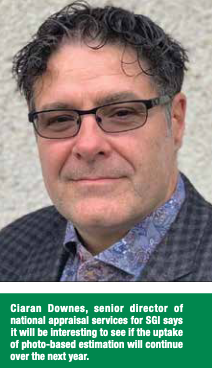“IN 2020, I WOULD ABSOLUTELY SAY WE’D BE MORE INCLINED TO WORK WITH A FACILITY WITH PHOTO-ESTIMATION PROCEDURES IN PLACE.” – MICHEL MARTINEAU, VP OF CLAIMS, DESJARDINS INSURANCE
For years, the industry has been reluctant to implement widespread photo estimating procedures. However, in the social distancing era, this once overlooked service has proved useful and is now both accepted and encouraged in the sector.
Photo-estimating is something that is clearly now a reality, says Michel Martineau, vice president of claims at Desjardins. While the process was merely “a vision of the future” a few short years ago, Martineau says Desjardins now uses photo estimation with its network of bodyshops as well as internally. He also said Desjardins would be more likely to collaborate with facilities using touchless processes.
“In 2020, I would absolutely say we’d be more inclined to work with a facility with photo estimation procedures in place.”
Ciaran Downes, senior director, National Appraisal Services at SGI agreed, saying there are a lot of advantages associated with photo estimating and accelerating claims processing.
“From an insurer perspective, we see photo-based estimating as a potential opportunity to assist us in identifying potential total-loss vehicles very early in the claims intake process, allowing us to triage the claim to the appropriate channel.”
While the process certainly proves useful— especially in modern times—the insurers also recognize the inevitable drawbacks of such new technology.
Martineau says photo quality can introduce hiccups in the estimation process.
“Sometimes we need to have additional pictures to ensure we’re making the right assessment of the amount of damages,” said Martineau.
Meanwhile, Downes says manual intervention is still required for writing estimates, and ‘desk appraisers’ may be unable to identify hidden damages by simply looking at submitted images, resulting in potentially inaccurate initial estimates.
Despite the drawbacks, the pandemic has made it clear that photo estimation is here to stay. Both Martineau and Downes believe facilities will continue to offer the service post-pandemic.
“We believe that many repairers who started to offer low-touch options during the pandemic will likely choose to continue to offer to customers photo-based estimating options post COVID-19, but it will be interesting to see if the uptake of photo-based estimating will continue over the next year. The scale and extent of the current pandemic will likely drive a lot of those decisions,” said Downes.
Martineau agreed and said photo-based estimating will likely be the new norm post-pandemic, but Desjardins will still be flexible and tailor estimation around the client’s preference.
“We want to be considerate of the client’s needs and the way they want to be taken care of. So, of course, it’s going to become the norm—for me that’s clear—but at the same time we want to adjust and when there’s the need and client’s situation requires it, we need to also need to be there to do it more the traditional way.”
At Desjardins, their main priority after the restrictions lift is protecting all employees, networks, and foremost our clients; while following the guidelines provided by the government, said Martineau.
“So, this may mean we have to change the way things are done but we want to make sure that the work is done properly with the right prioritization, while also taking care of everyone’s health.”






















